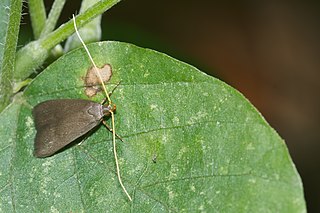Related Research Articles

The Lecithocerinae are a subfamily of small moths in the family Lecithoceridae. They are found worldwide, but most species occur in South Asia. The subfamily is characterized by the male genitalia with a bridge-like structure connecting the tegumen and the valva, and the uncus almost always is vestigal with two lobes at the dorsal base, only exceptionally united into a broad plate, but never as a thorn or spine.
Sulciolus abrasa is a moth in the family Lecithoceridae. It was described by Alexey Diakonoff in 1954. It is found in New Guinea.
Sulciolus capra is a moth in the family Lecithoceridae. It was described by Alexey Diakonoff in 1954. It is found in New Guinea.
Sulciolus pachystoma is a moth in the family Lecithoceridae. It was described by Alexey Diakonoff in 1954. It is found in New Guinea.
Sulciolus perspicua is a moth in the family Lecithoceridae. It was described by Alexey Diakonoff in 1954. It is found in New Guinea.
Sulciolus circulivalvae is a moth in the family Lecithoceridae. It was described by Kyu-Tek Park in 2012. It is found on New Guinea.
Sulciolus kaindiana is a moth in the family Lecithoceridae. It was described by Kyu-Tek Park in 2012. It is found on New Guinea.
References
- ↑ "Sulciolus Park, 2012" at Markku Savela's Lepidoptera and Some Other Life Forms. Retrieved July 15, 2017.
| This article relating to the subfamily Lecithocerinae is a stub. You can help Wikipedia by expanding it. |